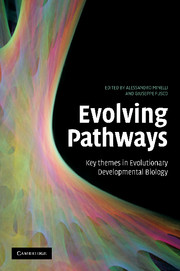Book contents
- Frontmatter
- Contents
- Contributors
- Preface
- Introduction: Pathways of change
- Part I Thinking about evolution by taking development on board
- Part II Evo-devo: methods and materials
- 7 A pragmatic approach for selecting evo-devo model species in amniotes
- 8 On comparisons and causes in evolutionary developmental biology
- 9 Evolution and development: towards a synthesis of macro- and micro-evolution with ecology
- 10 When is a Hox gene not a Hox gene? The importance of gene nomenclature
- 11 Plants are used to having identity crises
- Part III Evolving diversity
- Part IV Evolving body features
- Index
- References
9 - Evolution and development: towards a synthesis of macro- and micro-evolution with ecology
Published online by Cambridge University Press: 08 August 2009
- Frontmatter
- Contents
- Contributors
- Preface
- Introduction: Pathways of change
- Part I Thinking about evolution by taking development on board
- Part II Evo-devo: methods and materials
- 7 A pragmatic approach for selecting evo-devo model species in amniotes
- 8 On comparisons and causes in evolutionary developmental biology
- 9 Evolution and development: towards a synthesis of macro- and micro-evolution with ecology
- 10 When is a Hox gene not a Hox gene? The importance of gene nomenclature
- 11 Plants are used to having identity crises
- Part III Evolving diversity
- Part IV Evolving body features
- Index
- References
Summary
Until our population-based evolutionary theory can be reconciled with our homology-based evolutionary theory, we live without a true synthesis of evolutionary thought.
Amundson 2005: 249–250Evolutionary theory is the philosophical backbone of biology. Interestingly, contemporary research in evolutionary biology involves several parallel lines of investigations that build on different philosophies and aim for different kinds of explanations and mechanisms. At its extreme, at least three independent research activities are actively promoted in evolutionary biology: neo-Darwinism with a population genetics research agenda analyses the evolution of populations by natural selection (Amundson 2005). Molecular phylogeny tries to reconstruct historical patterns and the phylogenetic relationship of organisms using cladistic approaches. And finally, comparative morphology, and more recent ‘evo-devo’ research, build on the evolution of ontogeny and try to show how modifications of development (ontogeny) result in evolutionary novelties (Valentine 2004, Kirschner and Gerhard 2005).
All of these agenda are actively propagated and they all consider themselves to follow the Darwinian logic. Surprisingly, however, there is hardly any cross-talk between these disciplines and even worse, these research fields ignore each other to a certain extent. Several authors have emphasised the different research strategies and philosophies in contemporary evolutionary biology, i.e. neo-Darwinism and evolutionary developmental biology (Wilkins 2002, Amundson 2005). Despite these obvious problems and lack of interactions, we are in need of a true synthesis of evolutionary thought. And such a synthesis must include both population genetic and developmental thinking. In this context, homology could be an important concept.
- Type
- Chapter
- Information
- Evolving PathwaysKey Themes in Evolutionary Developmental Biology, pp. 160 - 174Publisher: Cambridge University PressPrint publication year: 2008



